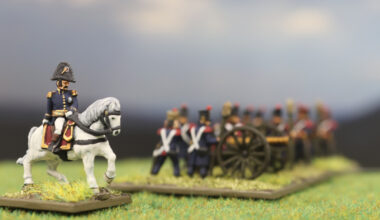A Prussian is never late, nor is he early… actually, no, their arrival at Waterloo was a bit delayed, but thankfully they’re exactly on time for Epic Battles! A sea of blue and grey, the Prussians have arrived to see off Boney’s hordes and help bring a prolonged period of peace to Europe. While the stout and disciplined Prussian regulars will no doubt form the bulk of your force, today I want to give some love to the oft-overlooked and underappreciated militiamen of the Landwehr.
Formed by Royal decree as part of a doctrine of ‘universal conscription’ wherein all Prussian men would serve in the army in some capacity, the Landwehr were part-time reservists, serving only for a few weeks annually or for the duration of a particular campaign or emergency. Given the parlous state of Prussian finances at the time, these second-rate units (made up of those too old or otherwise unfit for regular service as well as those who had previously served their time in the standing army) were equipped mostly at the expense of their local authorities. In the early days, many men were thus armed only with pikes or scythes due to a shortage of firearms, but by the time of the Hundred Days virtually all were equipped with muskets, due in large part to assistance given by Great Britain, as well as captured French stocks.
Their uniform too was designed for economy rather than style (a definite departure from military convention of the era). Landwehr wore mostly the blue Litewka coat with collars and cuffs in their provincial colours and white or grey trousers – this clothing had a poor reputation for quality. In particular the shoes, of which only one pair per man was issued, had a tendency to fall apart or come off in thick mud, meaning many of the Landwehr went into battle barefoot (as depicted on our splendid miniatures)! Various ‘non-standard’ colours (funny… -ed.) were carried until this was prohibited by decree in late 1813. A new regulation design was not adopted until 1816, meaning that most of the units present at Ligny and Waterloo likely fought without colours. However, we’ve made sure to add a flag sheet to the Brigade box and a standard pole to each sprue to give hobbyists the option to field them with colours should they so choose – we all agree that they look much cooler with them!
In combat, the Landwehr’s performance varied dramatically. On several occasions battalions broke and fled in disorder, while at Lowenberg the Schweidnitz battalion fought so bravely that Yorck ordered the line regiments of the army to present arms to the Landwehr as they marched to the rear having expended their entire stock of ammunition. Similarly, at Ligny, the 2nd Battalion of the 1st Westphalian Landwehr formed square on a hilltop and repulsed three charges by French cuirassiers and Imperial Guard cavalry. By Waterloo, the majority of Landwehr units were very near to equalling the regulars in battlefield prowess. Blücher wrote, “At first it was only so-so with the Landwehr battalions, but now that they’ve had a good taste of powder, they’re as good as the line battalions.”
Napoleon, meanwhile, had a rather lower opinion of the reservists, saying “The enemy infantry is absolutely wretched; this encourages me,” upon seeing some recently-captured Landwehr. Of course, we all know who had the last laugh there!
There were also Landwehr cavalry – at Waterloo, 40 percent of the Prussian cavalry were Landwehr, outfitted with lances and sabres in imitation of the Cossacks. Uniformed much like their infantry cousins, their effectiveness was somewhat debatable, but their enthusiasm was never in doubt! Naturally, we’ve included a regiment’s worth of them in the Brigade box, perfect for pursuing the French all the way to Paris! If you can rein them in, they’ll do solid service scouting and guarding your flanks.
Finally, the boxed set includes a unit of skirmishing Jägers – to stay with the militia theme, they make ideal Volunteer Jägers, members of the educated middle classes who served as effective skirmishers. Many of these young men went on to command Landwehr units, and this professionalism did much to improve the fighting quality of the Landwehr over time. Use these well-motivated troops to screen your massed battalions as you march to Wellington’s aid – the French Voltigeurs won’t know what hit them!
On the Epic Battles tabletop, your Landwehr regiments will augment the regular line infantry, forming the classic ‘mixed’ Prussian brigades. Slightly cheaper than Musketeers and Fusiliers, they do suffer from the Unreliable special rule but are in all other respects thoroughly acceptable frontline units. When well led, they’ll do their commanders proud, and their burning hatred of the French gives them the Tough Fighters rule, meaning they can re-roll a single failed dice roll in hand-to-hand combat in each round of fighting. While taking a run at the Imperial Guard might not be the best idea in the world, your plucky militiamen are certainly no slouch with the bayonet!
Similarly your cavalry, while also unreliable, are capable and numerous, and determined to get stuck into the French with their lances. Finally, the Jägers have the Reliable and Elite 5+ rules (enabling recovery from disorder) and are crack shots with their rifles. Scatter a few companies throughout your army and watch with pride as they empty saddles and harass enemy officers.
Take up your musket, Kamerad – Wellington calls for aid, and Prussia will answer. Onwards to Paris!
















1 comment
Hi Marcus! I can’t find the rules for the Jäegers in the Epic Battles: Waterloo rulebook. If I’m correct they should be on pages 210-211 in the points section, but they are not there!
Comments are closed.